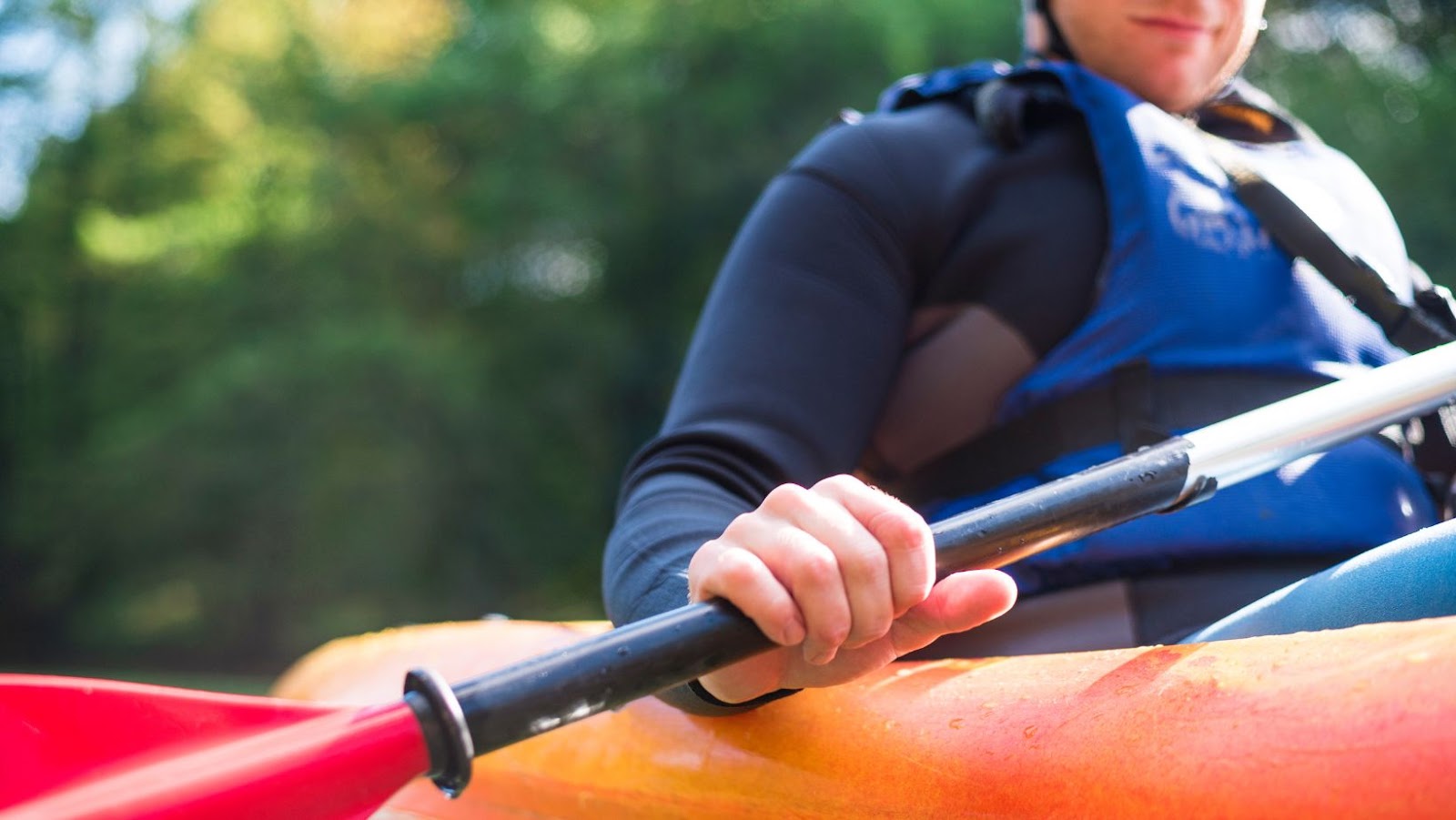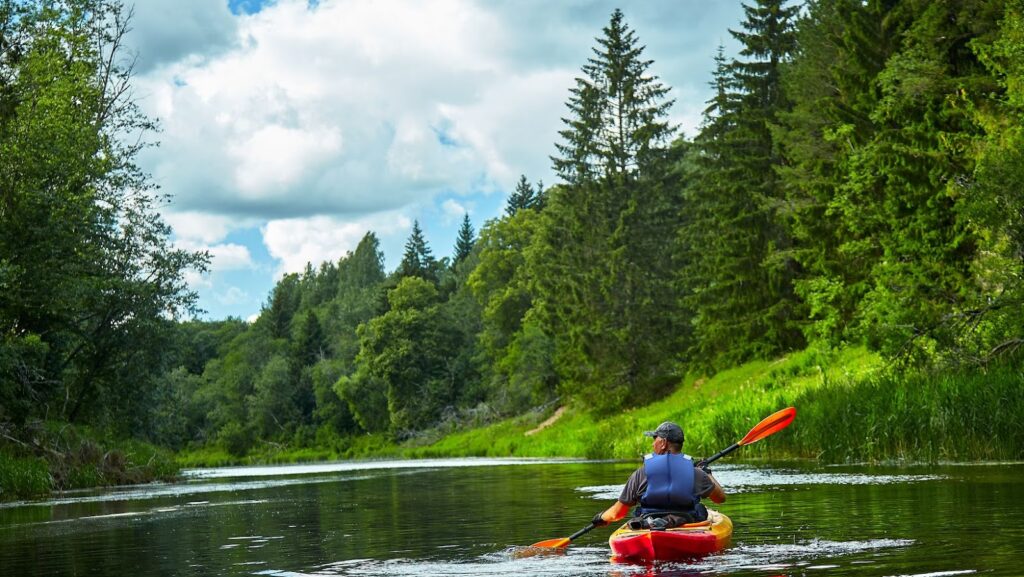
Going for a kayaking trip can be a lot of fun, but you must make sure you are prepared and have the appropriate gear. One of the most important items of equipment is a life jacket.
Wearing a life jacket is a must for kayakers, and it can help keep you safe and secure while out on the water. In this article, we’ll discuss what to wear when kayaking and why a life jacket is essential.
The Importance of Wearing a Life Jacket
Life jackets should always be worn when kayaking, as they provide you with protection and buoyancy in the event of a capsize or swamping. Wearing a life jacket helps to prevent drowning, especially when you are in unfamiliar waters. The life jacket also provides warmth if you get cold, and an anchor if you take a swim to cool off. Wearable flotation devices (PFDs) provide greater range of motion while adding buoyancy and protection.
Regular life jackets are suitable for most paddlesports activities like kayaking, canoeing, rafting, stand-up paddleboarding (SUP), fishing and motor boating. There are different types of PFDs designed for specific activities or body types; whatever your body type or discipline choice, there is sure to be one that fits comfortably and securely. Inflatable PFDs can be deflated for storage or packing into tight spaces. Always make sure your PFD is appropriate for your activities; select one that fits snugly but still allows full mobility and freedom of movement on the water.
Whether buying a new life jacket or choosing from an existing collection, ensure the device is properly fitted for comfortable wear during any water activity — it’s best to have it fit snugly so it does not ride up over your chin when in the water. Make sure to check each life jacket’s certification label indicating U.S Coast Guard approved standards before purchasing it; wearing a U.S Coast Guard approved PFD will make water recreation much safer as they must meet federal regulations regarding design and durability testing before being sold as approved personal floating devices (PFDs).
Types of Life Jackets
It’s essential to wear a life jacket when kayaking to make sure you stay safe. When picking the right life jacket it’s important to consider the type of kayaking you will be doing, the temperature of the water, and your body size and shape.
It’s also important to decide what kind of life jacket you are looking for in terms of comfort, size and style. Let’s take a look at the types of life jackets available.
Inflatable Life Jackets
Inflatable life jackets are a popular choice among kayakers because they are lightweight, breathable, and comfortable. Inflatable life jackets (often referred to as PFDs or personal flotation devices) come in two main varieties: manual and automatic. Automatic inflatable life jackets feature a CO2-powered inflation system, activated by an inflator mechanism located on the jacket that is set off when immersed in water. Manual inflatable life jackets require the user to pull the inflation toggle to initiate inflation of the jacket’s chambers.
Inflatable life jackets also come in different materials. Nylon jackets have a slim design that makes them easily packable and they are often used for ocean adventures while foam neoprene jackets add extra insulation against water temperatures and have additional pockets for storage of kayaking accessories like safety whistles and signaling mirrors. For added protection, look for models with reflective panels which provide improved visibility when out on the water at night or during times of low light conditions.
For maximum comfort and performance, take into account your body type and weight when choosing an appropriate size of inflatable life jacket. Make sure to test out your PFD prior to wear by inflating it either manually or automatically as recommended by the manufacturer – this will alleviate any flaws in manufacturing or wear-and-tear that may affect the functioning of your PFD out on the water!
Foam Llife Jackets
Foam life jackets, also known as flotation device or personal flotation devices (PFDs), are the most common type of life jacket in use today. This type of life jacket is typically constructed from an outer shell of either neoprene or plastic foam filled with synthetic foam. It has straps that secure across the chest and back and can be adjusted to ensure a secure fit.
The advantage of foam jackets is their minimal bulkiness, which makes them ideal for activities like kayaking. They are also very affordable and come in many different colors and sizes to suit the needs of users. Some types also come with built-in reflective strips, which can improve visibility in low light conditions so they can be seen more easily by rescue personnel.
How to Choose the Right Life Jacket
Having the right life jacket for kayaking is essential for staying safe. But how do you know which life jacket is right for you? Before you go on your next kayaking adventure, let’s take a look at what factors to consider when choosing a life jacket, and how to ensure that you make the right selection.
Consider The Type of Kayaking Activity
The type of kayaking activity, as well as the water environment, should be taken into account when choosing the right life jacket. Factors to consider include:
-The conditions of the water environment. For example, if you will be kayaking in open ocean waters where there are rough waves, choppy waters or strong currents, a high buoyancy life jacket is recommended. This type of life jacket will provide you with more support and keep you afloat if you fall overboard.
-The wind level on that particular day will also play an important role in determining what type of life jacket would be most suitable. If there are strong winds and waves that could create more danger for kayakers, higher buoyancy jackets with straps and buckles might be best. These straps and buckles enable quick fitting while helping to stabilize the body against windy conditions.
-If whitewater rafting or river running is on your agenda, you’ll want to choose a lighter weight Type III PFD that won’t impede your movements through the rapids. It is important to note that all forms of whitewater paddling require Type 5 PFDs—a much larger flotation device than a typical Type 3—to meet safety regulations in some areas.
By taking into consideration the kayaking activity at hand and the overall water environment, choosing the right life jacket can significantly reduce risk while ensuring our peace of mind during each outing at sea!
Consider The Size and Weight of The Life Jacket
The size and weight of the life jacket you choose can make a great difference in your safety and comfort while kayaking. It’s important to select a proper fitting jacket that will provide adequate floatation and buoyancy. A life jacket that is too small or too big won’t help you stay afloat if you unexpectedly capsize or become separated from your kayak.
When shopping for a new life jacket, take note of the sizing information found on the inside label. Life jackets come in a variety of sizes, from extra-small (XS) to extra-large (XL). Whenever possible, measure your chest size before purchasing with the help of a measurement tape or ruler. With measured dimensions, use the manufacturer’s size charts when selecting from different models to find one with sufficient flotation for your body size and weight class.
It’s also good to consider how much weight capacity is necessary for each type of activity before selecting a life jacket. If you plan on using it mostly for recreational purposes such as lounging in calm waters or fishing, opt for an appropriately lightweight model capable of safely supporting your entire body while remaining breathable and comfortable while active. On the other hand, those paddling more extreme conditions may find heavier weight options more suitable as they often provide greater buoyancy and additional features geared towards enhanced safety in turbulent waters and other harsh environments such as through-deck pockets or special straps built into reinforce survival scenarios in case of an emergency situation.
Consider The Features of The Life Jacket
When selecting a life jacket for kayaking, it’s important to consider the features that best suit the activity. Look for life jackets made with lightweight materials and foam, as these are more comfortable when paddling. Make sure the life jacket is appropriately sized — it should fit snugly but still allow you to move comfortably and easily. Choose a bright colored option so you can be seen in any water environment. Additionally, make certain your life jacket has pockets or loops where you can attach compasses, radios or other small items without hindering your motion.
Other features may also be beneficial for kayaking:
- Adjustable straps and clips – Ensure that the jacket fits properly and can be adjusted quickly if needed.
- Mesh backing – Improves ventilation on hot days and helps reduce condensation on kayaks that may have been out of the water for some time.
- Whistle attachments – Handy in case of emergency to alert those around you or to signal help from afar.
- Solar reflectors – For improved visibility in low light situations.
- Reflective tape – Gives added protection during night paddling trips. It reflects light from vehicles that might not otherwise know you’re there unless looking directly at your paddle path line up close.
Finally, make sure your life jacket is USCG (United States Coast Guard) certified – this means that it meets federal standards and has passed specific testing criteria including flotation tests, strength tests and buoyancy tests as well as comfort evaluations such as mesh breathability tests key word what to wear when kayaking). It also ensures that any age designated jackets fit properly form infants all the way through adults size XLG 48″ Chest per Waist 2XL over 55″ & LB 12Lbs age 4mos + they have PFD’s (personal flotation devices) or Life Jackets!!!!!
Other Essential Items to Wear
When kayaking, it is essential to wear more than just a life jacket. While participating in this sport, you should consider clothing, footwear, and other accessories that can help you stay safe and comfortable throughout your journey.
This section will explore different items of clothing, footwear, and accessories that are essential to wear when kayaking.
Wetsuits
Wetsuits provide a layer of thermal protection when kayaking, both in summer and winter. Wetsuits should fit comfortably and snugly, but shouldn’t pinch or bind as you move. Most wetsuits are made from several layers of neoprene — a type of synthetic rubber — that can help prevent hypothermia by trapping warm water next to your skin.
If you plan to be in the water for an extended period of time, invest in a wetsuit made from thicker neoprene material. Wetsuits come with varying levels of thickness measured in millimeters (mm). We recommend selecting a 3/2mm wetsuit for common use — two millimeters for the body core and three millimeters over the limbs. If you plan to kayak in colder weather or if temperatures will fluctuate, consider investing in a 4/3mm combination or even add a full-length neoprene jacket on top of your current wetsuit.
In addition to providing insulation and warmth, wetsuits also protect against abrasion (e.g., rocks) and UV radiation (sun). Both long johns with long sleeves and full body suits are available to keep paddlers safe when they’re out on the water. Look for features such as adjustable collars, built-in padding around vulnerable areas, adjustable ankle cuffs and attached hoods that keep your head warm when needed. Finally, be sure to apply zinc oxide sunscreen on exposed skin before wearing your wetsuit!
Shoes
Shoes are just as important when kayaking as a proper fitting life jacket. You will want to wear a closed-toe shoe with good grip that you don’t mind getting wet. Throw on some durable shoes with good support, such as water shoes, because even if you have to get in the water and push your kayak they will be able to handle it.

It is highly recommended to wear thick socks with your shoes as they absorb moisture and can protect your feet from blisters caused by extended periods of walking in wet shoes. It’s also important to ensure the laces are tied tightly so that they do not become undone while paddling.
Sun Protection
It is important to protect yourself from the sun while kayaking. Wear sunscreen with at least SPF 30 and both UVA and UVB protection. Additionally, try to wear lightweight clothing that covers your arms and legs to minimize sun exposure, such as light pants, a long-sleeve shirt, or a rash guard.
To keep it out of your face while paddling, wear a wide-brimmed hat or use an SPF 50+ water resistant sunscreen for your face. Sunglasses with polarized lenses will help reduce glare on the water and protect your eyes from any reflected radiation from the atmosphere.
Wearing the proper safety gear when kayaking is imperative to ensuring your safety during your excursion.
Life jackets are the most important piece of kayaking gear you should own – it is the one piece of gear that can save your life in an emergency situation.
In this article, we have discussed the importance of wearing a life jacket when kayaking and what you should wear in order to ensure your safety.
Summary of The Importance of Wearing The Right Safety Gear When Kayaking
Kayaking is a fun water sport, but it can also be dangerous if you are not aware of the safety protocols. One essential piece of safety equipment for kayaking is the life jacket. A life jacket will help you float in the event of an accident or capsizing. It also helps protect your head from impact with obstacles like trees, underwater barriers, or other boats. Wearing the right type and size is important – make sure to select one that allows you full range of movement and fits correctly around your torso and upper body.

Another piece of safety equipment when kayaking is a helmet. Just like on a bike, a helmet provides protection against any hazards on waters with strong currents as well as any potential rocks or other obstructions beneath the surface. It’s also important to wear appropriate clothing when kayaking, such as quick-dry or neoprene material, which will help keep you warmer in cold water conditions and protect against abrasions if needed.
By following these simple tips and selecting the correct gear for your kayaking adventures, you can rest assured that you are prepared to tackle any situation on the water and enjoy safely this thrilling outdoor activity!




